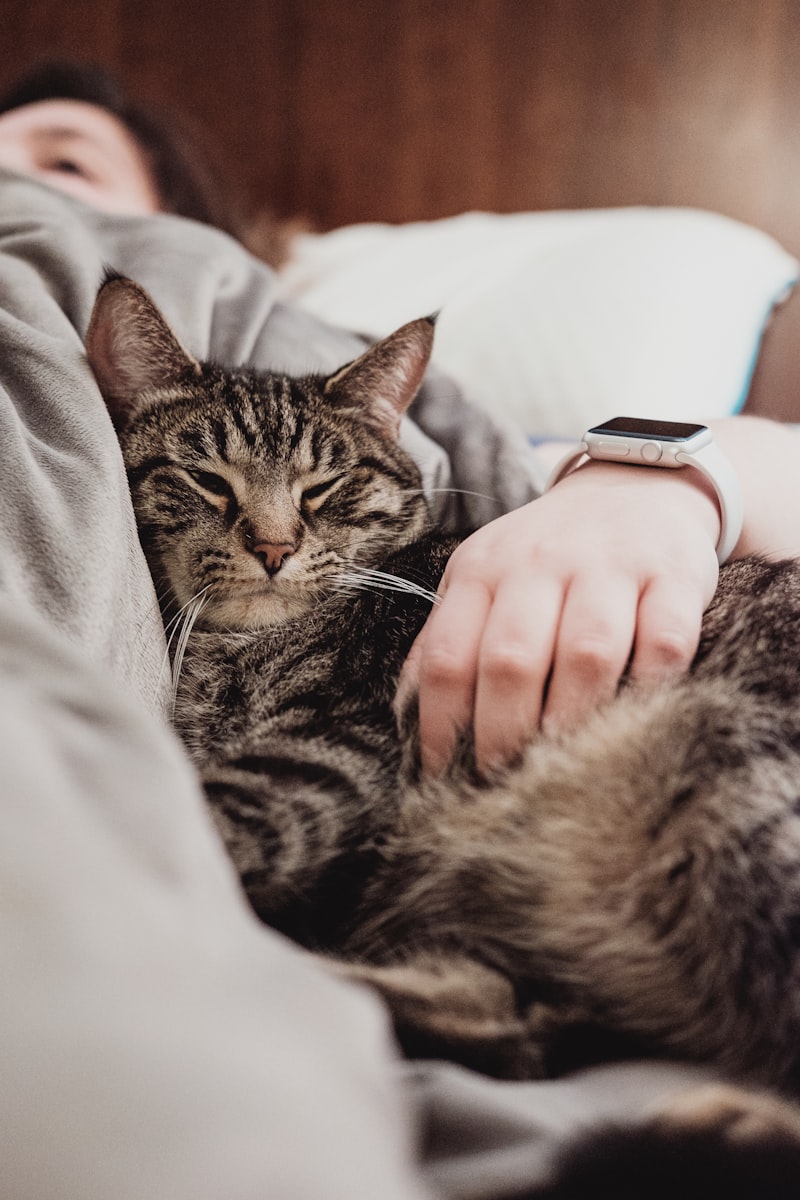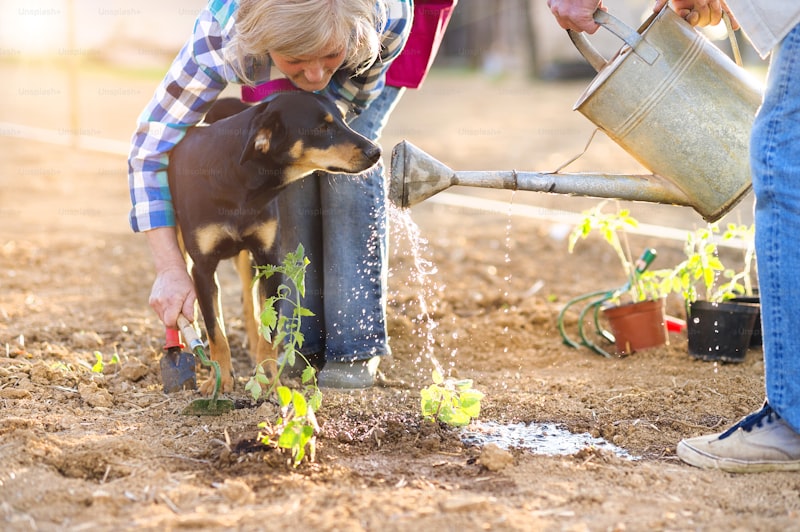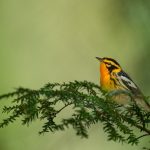Opt for pet-friendly plants that are non-toxic to dogs and cats. Examples include marigolds, sunflowers, and pet grass. Avoid toxic plants like lilies, azaleas, and daffodils, which can be harmful if ingested by pets.
Designate specific areas for your pets to play and roam freely. Use fencing or natural barriers to separate these areas from your delicate plants. This not only protects your garden but also provides a safe space for your pets to explore.
Choose pet-safe mulch options such as cedar or pine wood shavings. These not only deter pests but also provide a comfortable surface for pets to walk on. Avoid cocoa mulch, which contains substances toxic to pets if ingested.
Store gardening chemicals, fertilizers, and pesticides in secure, pet-proof containers and keep them out of reach. Opt for organic or pet-safe alternatives whenever possible to minimize risks to your pets’ health.
Pets love to dig, so designate a specific area where digging is allowed. Encourage this behavior by burying toys or treats in the designated area to keep your pets engaged and away from other parts of your garden.
Ensure your garden has shaded areas where pets can rest comfortably during hot weather. Place water bowls in multiple locations throughout the garden to keep pets hydrated while they play outdoors.
Regularly clean up pet waste to maintain a clean and odor-free garden. Use pet-friendly enzymes or compostable bags to dispose of waste properly without harming your plants.
Train your pets to respect the garden boundaries and supervise them during outdoor time. Positive reinforcement and consistency in training will help them understand where they can and cannot go.
Creating a pet-friendly garden requires thoughtful planning and consideration for both your plants’ health and your pets’ safety. By implementing these tips, you can create a harmonious outdoor space where both your garden and your pets can thrive together.
Paws and Plants: Safeguarding Your Garden for Pets
-
Choose Pet-Friendly Plants: Opt for plants that are non-toxic to pets. Examples include marigolds, sunflowers, and pet grass. Avoid toxic plants such as lilies, azaleas, and oleanders, which can be harmful if ingested by pets.
-
Create Safe Zones: Designate areas in your garden where pets can play freely without accessing potentially hazardous plants or chemicals. Use fences, raised beds, or barriers to keep them away from areas where you use pesticides or fertilizers.
-
Mulch Mindfully: Some types of mulch, such as cocoa bean mulch, can be toxic to pets if consumed. Choose pet-safe mulch options like cedar or pine instead. Ensure mulch is spread evenly to prevent pets from digging.
-
Secure Garden Tools: Store gardening tools, including trowels, shears, and fertilizers, in a secure location out of your pet’s reach. Sharp tools and chemicals pose risks if pets accidentally come into contact with them.

Water Safety: If you have a pond or water feature, ensure it is safely fenced off or covered to prevent pets from falling in or drinking excessively. Stagnant water can also pose health risks to pets.
-
Supervise and Train: Supervise your pets while they are in the garden, especially young animals or those prone to chewing. Train them to understand boundaries and redirect their attention to designated play areas.
-
Pet-Friendly Paths: Create paths using pet-safe materials like gravel or smooth stones. This helps prevent muddy paws and makes it easier for pets to navigate the garden without damaging delicate plants.
-
Garden Furniture: Choose sturdy, pet-friendly garden furniture that won’t tip over easily if pets climb on it. Avoid sharp edges or materials that could harm your pets.
-
Regular Inspections: Periodically inspect your garden for any hazards or potential risks to pets. This includes checking for toxic plants, loose fencing, or any other safety concerns.
-
Consult Your Vet: If you’re unsure about the safety of certain plants or garden practices, consult your veterinarian for advice tailored to your pet’s specific needs.
Green and Safe: Pet-Friendly Gardening Essentials
Firstly, choosing the right plants is crucial. Opt for pet-safe varieties like lavender, rosemary, and marigolds, which not only add color and fragrance but are also non-toxic to cats and dogs. Avoid plants like lilies, azaleas, and tulips, which can be harmful if ingested by pets.
Another key aspect is the use of natural fertilizers and pesticides. Organic options such as compost and mulch enriched with natural nutrients are not only beneficial for the soil but also safe for pets that may roam and explore the garden. These alternatives reduce the risk of exposure to harmful chemicals found in conventional products.
Creating designated play areas within the garden can enhance your pet’s experience outdoors. Consider installing pathways or gravel patches where pets can walk comfortably without damaging delicate plants. Incorporating sturdy yet pet-friendly furniture like benches or low tables allows both you and your furry friends to enjoy the garden together.
Furthermore, ensure proper fencing or boundaries to prevent pets from wandering into potentially hazardous areas or neighboring gardens. This helps maintain a safe environment while giving pets the freedom to explore within the designated space.
Ultimately, a pet-friendly garden harmonizes nature with the needs of your beloved animals. By carefully selecting plants, using natural products, creating safe play zones, and establishing boundaries, you create a haven where both you and your pets can relax and thrive amidst the beauty of nature.
Garden Bliss for Furry Friends: Creating a Pet-Safe Haven
Imagine stepping into a garden where every plant, every corner, is a safe haven for your beloved furry friends. Creating a pet-safe garden is not just about aesthetics; it’s about ensuring your pets can roam freely without any risks. Here’s how you can turn your outdoor space into a blissful sanctuary for your pets.
Firstly, consider the plants you choose. Opt for pet-friendly varieties such as marigolds, roses, and sunflowers, which not only beautify your garden but are also safe for curious noses and paws. Avoid toxic plants like lilies, azaleas, and daffodils, which can be harmful if ingested by pets.
Create designated play areas where your pets can romp around freely. Incorporate durable toys and equipment that are safe for them to interact with. For example, a sturdy scratching post for cats or a non-toxic ball for dogs adds both fun and safety to their playtime.
When it comes to landscaping, think about pathways that are easy on your pets’ paws. Gravel or soft mulch paths are gentle and comfortable for them to walk on. Ensure these paths lead to shaded spots where they can rest comfortably during hot days.

Water features can be enticing for pets, but safety is paramount. If you have a pond or fountain, make sure there’s easy access in and out to prevent accidental drowning. Consider shallow water bowls that are regularly filled with fresh water to keep them hydrated.
Fencing is crucial in creating a secure environment. Check for any gaps or weaknesses that could allow pets to escape or intruders to enter. Reinforce or repair fences as needed to maintain a safe boundary.
For pet owners with green thumbs, organic gardening practices are not only beneficial for plants but also safer for pets. Avoid chemical fertilizers and pesticides that could harm pets if ingested or absorbed through their skin.
Lastly, create shaded retreats with cozy spots for your pets to relax in. Whether it’s a comfortable bench under a tree or a small canopy, providing shaded areas protects them from the sun’s heat and allows them to enjoy the outdoors comfortably.
Grow Smart: Pet-Friendly Plants for Your Garden
When you’re planning your garden, it’s important to consider not just the aesthetic appeal but also the safety of your furry friends. Choosing pet-friendly plants ensures a beautiful garden that’s also a safe environment for your pets to roam freely.
Pet-friendly plants are those that pose minimal risk to animals if ingested. This is crucial as some common garden plants can be toxic to pets, causing anything from mild gastrointestinal upset to more severe reactions. By opting for pet-safe varieties, you can enjoy your garden without worrying about potential hazards to your beloved pets.
-
Spider Plant (Chlorophytum comosum): Known for its air-purifying qualities, the spider plant is safe for both cats and dogs.
-
Basil (Ocimum basilicum): This aromatic herb not only adds flavor to your dishes but is also safe for pets to nibble on.
-
Calathea (Calathea spp.): With its vibrant foliage, calathea plants are non-toxic and perfect for adding a tropical touch to your garden.
-
Areca Palm (Dypsis lutescens): A popular indoor and outdoor plant, the areca palm is safe for pets and adds a lush, tropical feel.
-
Blue-Eyed Grass (Sisyrinchium angustifolium): Despite its name, this grass-like perennial is non-toxic and adds a splash of blue to your garden.
Incorporating these pet-friendly plants into your garden not only enhances its beauty but also creates a safe haven for your pets. Imagine them lounging under the shade of a non-toxic palm or exploring amidst the spider plant’s cascading leaves. It’s a garden where both beauty and safety thrive together.
By choosing pet-friendly plants like spider plants, basil, and calathea, you can cultivate a garden that’s both visually stunning and safe for your pets. Whether indoors or outdoors, these plants not only enrich your living space but also provide peace of mind knowing that your garden is a sanctuary for all inhabitants, furry or leafy.
Frequently Asked Questions
What are essential pet-safe plants for my garden?
Discover essential pet-safe plants for your garden with our concise guide. Learn which plants are safe for pets to ensure a beautiful and pet-friendly outdoor space.
How do I handle pet waste in my garden responsibly?
Learn how to responsibly manage pet waste in your garden with our concise guide. Discover effective methods to minimize environmental impact while maintaining a clean and healthy outdoor space.
What are effective ways to keep pets out of my garden beds?
Discover effective methods to keep pets out of your garden beds with our concise FAQ. Learn practical solutions to deter pets without harm, ensuring your plants stay protected.
How can I create a pet-friendly garden space?
Learn how to create a pet-friendly garden space with practical tips on choosing pet-safe plants, designing secure boundaries, and providing shaded areas and water sources for pets.
Which gardening products should I avoid for pet safety?
Discover essential guidelines on ensuring your garden is safe for pets by learning about gardening products that should be avoided. This FAQ provides concise advice to protect your pets from potentially harmful substances commonly found in garden supplies.


